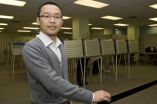(Press-News.org) With a lifelong interest in politics, University of Cincinnati researcher Muer Yang spent the last two years developing a quantitative method for allocating voting machines that could significantly reduce the average wait time of voters.
During the 2004 U.S. presidential elections, some voters waited in lines for more than 10 hours to cast their ballots, and in Ohio, the last vote was cast at 4 a.m., noted Ohio Secretary of State Jennifer Brunner in a public report. Ohio lines in the '06 and '08 elections were still so lengthy that they essentially "disenfranchised" voters unable to wait that long, said UC College of Business PhD candidate Yang. He wanted to change that.
To test his method in a computer-simulation model, he used 2008 presidential election data from Franklin County, Ohio, and found that, under simulations, his allocation method reduced the average voter wait time by 36 percent and specifically reduced queuing times for 23,000 people who had to wait for more than 30 minutes in that election.
His intention was to find a way to allocate voting machines to polling locations "so that all voters wait approximately equal amounts of time regardless of the precinct in which they happen to vote," Yang said of the quantitative analysis and operations management research he is conducting with program director David Kelton, UC associate professor Michael Fry and Ohio State University associate professor Theodore Allen. "We seek to provide equity to all voters so that no one particular group of voters is disadvantaged or disenfranchised," Yang said.
Election boards traditionally use a simple straight-forward mathematical model to allocate voting machines within a precinct, based on the number of voters and available machines, he said. "And that looks very fair, but they oversimplify the problem.
"Their assumptions of those problems are not even close to the real world," he added, "because that model assumes a stationary voter arrival — that voters arrive at the voting station at the same rate, which is not true. We use simulation models to consider realistic complications, including variables such as voter arrival time, voter turnout, length of time needed to finish a ballot, peak voting times and machine failures."
Those numbers can vary significantly between precincts.
Franklin County's voter-machine allocation method is typical to what is used in many areas of the country, but the Ohio county had several characteristics that made it a prime choice to test: It contained an urban core, suburbs and rural areas, leading to a highly diverse voter population, as well as the potential for significant differences in ballot composition.
As if validating Yang and his professors' test case selection, Secretary of State Brunner issued a report last year stating, "Franklin County voters suffered from one of the most disproportionate allocations of voting machines last November. Race and income may have also factored into the wait, according to some election observers."
Last, and just as important, "Ohio, and Franklin County in particular, have been pivotal in recent presidential and congressional elections," Yang said. In August, Time magazine called Ohio "the grand prize of presidential politics."
While conducting the research, the UC team worked closely with Brunner's office, and last fall they were directly involved in providing advice to modify Ohio legislation regarding the allocation of voting machines. House Bill 260, which comprises sweeping election reform well beyond the issue of voting machines, passed through the House of Representatives, but has not made it through the Senate.
Nevertheless, Yang has been excited to see officials take his work seriously. "The local board of elections was really happy that we could provide them with a new easy-to-use tool that didn't ask them to buy more machines," he said. "Our final goal was to provide them with an impartial, practical tool that could be of significant social importance. And they were glad to see that."
Research has concluded, and Yang is anxiously awaiting word on the team's submission to the field's leading journal. Last year, they presented a working paper at the 2009 Winter Simulation Conference.
INFORMATION:
Voting-machine-allocation method could reduce voters' wait time by 36 percent
University of Cincinnati College of Business researcher uses simulation to make voting times equal for all voters and to ensure exorbitant waits 'disenfranchise' no one
2010-11-02
ELSE PRESS RELEASES FROM THIS DATE:
Study: Race plays a minor role in forging Facebook friendships
2010-11-02
CAMBRIDGE, Mass., Nov. 1, 2010 -- Race may not be as important as previously thought in determining who befriends whom, suggests a new study of American college students' habits on Facebook. The findings, by a pair of sociologists from Harvard University and UCLA, appear in the current issue of the American Journal of Sociology.
The strongest attraction, the researchers found, turned out to be old-fashioned social pressure. For the average student, the tendency to reciprocate a friendly overture is seven times stronger than the attraction of a shared racial background.
"We ...
King crab distributions limited by temperature in the Southern Ocean
2010-11-02
Invasions of voracious predatory crabs due to global warming could threaten the unique continental-shelf ecosystems of Antarctica, according to newly published findings.
"King crabs are ecologically important predators and form the basis of economically significant commercial fisheries," said Dr Sven Thatje, an evolutionary ecologist at the University of Southampton's School of Ocean and Earth Science (SOES), which is based at the National Oceanography Centre in Southampton.
Thatje and graduate student Sally Hall studied how water temperature influences the distributions ...
Scientists find that evergreen agriculture boosts crop yields
2010-11-02
THE HAGUE (2 November 2010)—A unique acacia known as a "fertilizer tree" has typically led to a doubling or tripling of maize yields in smallholder agriculture in Zambia and Malawi, according to evidence presented at a conference in the Hague today. The findings were central to the arguments of agroforestry experts at the conference, who urged decision makers to spread this technology more widely throughout the African nations most vulnerable to climate change and food shortages, and to think differently about more practical ways to solve the problems that are most pressing ...
At great expense, railroad bypassed first black-founded town in the US
2010-11-02
CHAMPAIGN, lll.— Ignoring topography, efficiency, expense and even their own surveyors' recommendations, regional railroad officials in the mid-19th century diverted a new rail line around New Philadelphia, Ill., "the first town in the United States planned, platted and legally registered by an African American," a University of Illinois researcher reports. The bypass pushed what would have been a fairly straight, even run of railroad tracks from Griggsville, Ill. to Hannibal, Mo., in a wide, hilly arc around New Philadelphia.
The findings, reported in Historical Archaeology, ...
For elderly, even short falls can be deadly
2010-11-02
While simple falls, such as slipping while walking off a curb, may seem relatively harmless, they can actually lead to severe injury and death in elderly individuals, according to a new study published in The Journal of Trauma: Injury, Infection, and Critical Care. As the population continues to age, it is important for physicians and caregivers to be aware of and prepared to deal with this issue, which could significantly impact the overall health and wellbeing of older adults.
In contrast to falls from greater heights, ground-level falls – essentially falls from a ...
New American Chemical Society podcast: Stop wasting food and save energy
2010-11-02
WASHINGTON, Nov. 1, 2010 — Generations of Moms and Grandmas have preached the virtues of not wasting food. Now scientists are reporting a compelling new reason to follow this advice: It could save enormous amounts of energy, according to the latest episode in the American Chemical Society's (ACS) award-winning podcast series, "Global Challenges/Chemistry Solutions." They say that the United States could immediately save the energy equivalent of about 350 million barrels of oil a year — without spending a penny or putting a ding in the quality of life: Just stop wasting ...
Microreactor speeds nanotech particle production by 500 times
2010-11-02
CORVALLIS, Ore. – Engineers at Oregon State University have discovered a new method to speed the production rate of nanoparticles by 500 times, an advance that could play an important role in making nanotechnology products more commercially practical.
The approach uses an arrayed microchannel reactor and a "laminated architecture" in which many sheets, each with thousands of microchannels in them, are stacked in parallel to provide a high volume of production and excellent control of the processes involved.
Applications could be possible in improved sensors, medical ...
Diverse surgeons initiative effectively increases underrepresented minorities in academic surgery
2010-11-02
CHICAGO (November 1, 2010) – According to a report published in the October issue of the Journal of the American College of Surgeons, a grant-funded program tailored to provide advanced minimally invasive surgery skills to young, underrepresented minority surgeons, is helping address shortages of minority faculty members at US medical institutions.
The report states that the Diverse Surgeons Initiative (DSI) has helped 86 percent of graduates in the program acquire fellowship training. These outcomes surpassed the 2005 national percentage of fifth-year residents in academic ...
Inhaled steroids increase diabetes risk, say Lady Davis Institute researchers
2010-11-02
Patients taking inhaled corticosteroids are at increased risk of developing type 2 diabetes, and more so with higher doses, say researchers at the Jewish General Hospital's Lady Davis Institute for Medical Research (LDI) In Montreal. The risk is of special concern for patients suffering from chronic obstructive pulmonary disorder (COPD), and much less significant for asthmatics.
"These medications are very effective in asthma, so the benefits clearly outweigh the risk for asthmatics," said Dr. Samy Suissa, Director of the Centre for Clinical Epidemiology at the LDI, and ...
Common stomach bacteria may fight off inflammatory bowel disease caused by Salmonella
2010-11-02
Ann Arbor, Mich. — Helicobacter pylori, a common stomach bacterium, reduced the severity of inflammation of the colon caused by Salmonella in mice, according to research from U-M Medical School scientists.
More than half the people in the world are infected with H. pylori, although it is very unusual to find it in the United States. But this research shows there may be an inflammation control benefit to hosting the H. pylori infection, says Peter Higgins, M.D., Ph.D., M.Sc., lead author of the study published last week in the journal Inflammatory Bowel Diseases.
"If ...
LAST 30 PRESS RELEASES:
Autonomous AI agents developed to detect early signs of cognitive decline
Study finds ocean impacts nearly double economic cost of climate change
Increased deciduous tree dominance reduces wildfire carbon losses in boreal forests
Researchers discover how a respiratory bacterium obtains essential lipids from the human body and targets fat-rich tissues
Locust swarms destroy crops. Scientists found a way to stop that
More resources and collaboration needed to support prevention and treatment of obesity
Two types of underconfidence linked to anxiety and gender
Insects are victims too: Global study shows impacts of invasive alien species on populations
Pioneering natural, degradable polymer capsules
Forestry is becoming digital and automated
Maternity baby deaths much higher in northern England than in the South
Mosquitoes’ thirst for human blood has increased as biodiversity loss worsens
The stop-smoking medication varenicline may also work for cannabis use disorder
Potential new treatment for sepsis
Study reveals how many hours of video games per week might be too many
Electrospinning for mimicking bioelectric microenvironment in tissue regeneration
Home fingertip oxygen monitors less accurate for people with darker skin tones
Six weeks in a cast no less effective than surgery for unstable ankle fractures
Precautionary approach to alcohol-free and low alcohol drinks needed to protect public health, say experts
Gas-atomized Ca–Mg alloy powders produce hydrogen simply by adding water — high-efficiency hydrogen generation at room temperature
British redcoat’s lost memoir reveals harsh realities of life as a disabled veteran
World-leading rare earth magnet recycling facility launches in UK
Corday Selden selected for the Oceanography Society Early Career Award
MIT chemists determine the structure of the fuzzy coat that surrounds Tau proteins
Same moves, different terrain: How bacteria navigate complex environments without changing their playbook
Severe weather is deadly for vulnerable older adults long after the storm ends, study finds
Expert panel highlights opportunities for improving cancer studies
Hearing aid prescriptions not associated with changes in memory and thinking
Seth Zippel selected for The Oceanography Society Early Career Award
Jeremy Horowitz selected for The Oceanography Society Early Career Award
[Press-News.org] Voting-machine-allocation method could reduce voters' wait time by 36 percentUniversity of Cincinnati College of Business researcher uses simulation to make voting times equal for all voters and to ensure exorbitant waits 'disenfranchise' no one


